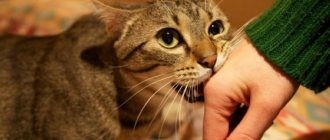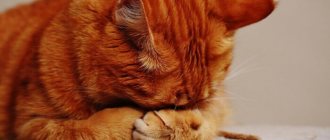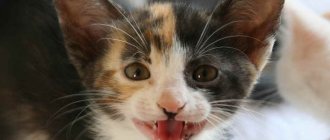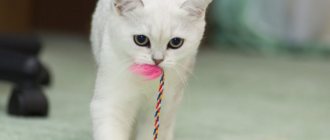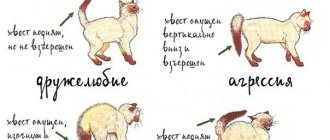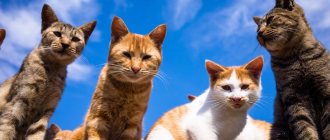Audio communication
Sound communication, for example, is used when greeting hosts, begging for food, or wanting to attract attention by expressing protest or making threats. In each of these cases, the cat makes sounds appropriate to the situation, differing in strength, timbre and tone. Moreover, states of pain, fear, aggression are accompanied by lower sounds, and satisfaction, tenderness or complacency - by higher ones. Cats often communicate with kittens using sounds that are in the ultrasonic range that is not perceptible to the human ear.
Purring means the cat is not aggressive at all. With this short trill, cats call kittens to themselves and greet their owners. A cat makes purring sounds to warn her kittens of danger when she is excited and excited. Rumbling is a warning sound addressed to surrounding people or other animals. A low (uterine) rumbling, almost a growl, is evidence that the cat is ready to defend itself. Another characteristic aggressive sound is hissing. A cat hisses only when it is frightened and does not have the opportunity to escape. Snorting, cats, as a rule, also lean forward a little, as if attacking, and menacingly strike the ground with their paw. This is a signal to fight when meeting with a more serious opponent. Another signal found in a cat's language is the clinking of teeth. Cats rarely resort to it, mainly when they see prey, for example, an unattainable bird sitting on a window, or when teaching growing kittens to hunt. This sound means approximately the following: “Attention! I see prey! Cats use vowel sounds, meowing, in particularly extreme situations. Thus, the sounds “meow”, “mi-au”, “me-au”, “mew” and others express a request, complaint or bewilderment. Cats usually enrich their score, which over time their owners begin to understand. Meowing is conversation. Vowel sounds mean: “I want to go out!”, “It’s time to eat!”, “Feed me immediately!”, “I’m so bored and lonely!”, “Help!” and so on.
Photo tips on how to understand a cat
Read here What types of printing exist currently?
Help the site, share with friends 
Communicating with facial expressions
The entire arsenal of gestures with which a cat demonstrates its feelings and intentions, moods and states are innate. Kittens are born with full knowledge of the rules of behavior and instinctively show appropriate reactions. Watching little kittens play, you can notice that in their movements and games, postures and facial expressions there is everything that makes up the sign language of an adult cat.
The cat's half-closed eyes indicate that she is relaxed and at peace. Wide eyes express interest or concern, attention to what is happening around. If the environment causes fear in the cat, then the pupils sharply dilate. Squinting eyes or staring at someone means a challenge. If a cat averts its eyes to the side, it means it is showing its submission. The transition to aggression in a cat is accompanied by a sharp constriction of the pupils and concentration of attention on the subject of aggression.
The ears of cats are no less expressive. Ears facing forward mean that the cat is relaxed, interested in something, or greeting someone; heads horizontally lowered to the sides - aggressive; pulled back and pressed tightly to the head - in fear and confusion. When acting aggressively, the cat lowers its head low, and when in confusion, it lowers its head slightly. Nervous twitching of the ears means irritation or lack of self-confidence.
It is impossible to imagine a cat's facial expressions without moving its eyebrows and whiskers. If they are directed forward, the cat is interested in something, excited or ready for action; loose on the sides of the head - relaxed and calm; collected in buns and pressed to the cheeks - scared or alarmed.
A satisfied cat's mouth is closed or slightly open; as a sign of supreme bliss, especially in Persian cats, the tip of a relaxed tongue may protrude. An open mouth with tense or raised lips in a grin means that the cat intends to bite. Grinning or “Flemin's smile” means examining the odors that interest the cat, usually coming from animals of the opposite sex. And a long, full-mouth yawn exposing almost all the teeth and tongue is complete relaxation. Quickly licking your lips is a sign of anxiety or confusion.
Touch plays a huge role in cat communication. Sniffing and sometimes licking the anal area, temples or mouth is evidence of social hierarchy. A sniffed cat exhibits submissive behavior. Sometimes cats touch noses or press their heads together as a sign of friendship. When a cat rubs its head or body against another animal or makes a figure eight between your legs, it is showing a feeling of affection and sometimes a request for something. If a cat “butts”, rubs its forehead against the forehead of another cat or a person, it means that it is showing an element of intimate affection, which not everyone receives.
Cats use their paws and retractable claws in a very wide range: for exploration, play, hunting and intimidation. When a cat is irritated or worried about something, it strikes sharply with its front paw. In such cases, she does not release her claws, and the strike is preemptive. In this way, the mother cat stops the unwanted behavior of the kittens or the person communicating with her. Cats love to touch their owner's face with a soft touch with their claws retracted. This is how they often express a request to let them under the covers or, on the contrary, wake them up in the morning. Sometimes cats retain an infantile language of postures and body movements for the rest of their lives. For example, a cat, expressing its satisfaction from stroking and caressing a person, can move its front paws in time with its purring. This behavior is typical of kittens when they massage their mother's nipple.
Hiss
You don't need to be an expert in cat psychology to understand that hissing, high-pitched meows and growls are the animal's declaration of impending danger.
Seeing a neighbor's dog or cat, the pet may begin to defend its territory by making growling sounds. My cats react this way when puppies try to play with them: they don’t release their claws, but they scare them off with hissing and growling.
Sometimes an animal can react this way to an unfamiliar object: a hair dryer, a vacuum cleaner, a washing machine. If a cat hisses at someone on the street, it could be a hedgehog or snake lurking nearby.
Communicating with body movements
Cats are generally very frank in expressing their feelings. The movements of the cat's tail are especially expressive, by which, even without seeing the expression of the cat's face, one can judge the state and intentions of the animal. A raised tail always indicates a cat's friendliness and good mood. Kittens' tails, which are almost always in an upright position, symbolize their interest in the world around them. With its tail raised high, the cat rubs against its owner's legs, greets animals it knows, and invites them to play.
An alert cat's tail is down and ruffled. If the fur on it rises only at the base, the animal does not know what to do. Very frightened cats tuck their tail between their paws.
Aggression is demonstrated by a fully spread, tense and high tail in dominant animals and a lowered, arched tail in subordinates. The first sign of irritation is the rhythmic twitching of the horizontally extended tail. If the tail is down and thumping on the floor, the cat is more scared than angry. But if the movements of the tail increase, the tail twitches from side to side, and the cat begins to lash itself with it on the sides - this is pronounced aggression.
Swinging the tail has several meanings depending on the speed and which part of it is moving: lightly waving the tip of the tail indicates relaxation; the movement of the entire tail is slow at first, and then faster and faster, so that the cat’s croup begins to sway, occurring before jumping on the object of the hunt.
How can you understand a cat by its behavior and sounds?
Small predators are quite independent. For thousands of years, people have domesticated these animals not only for fun. This coexistence is very beneficial for both parties. At all times, cats protected houses from small snakes and rodents, scorpions and poisonous spiders, receiving a bowl of milk or a piece of treat.
Cats easily remember nicknames and conventional signals. Observant people wonder whether cats understand human speech. People have always wanted them to master a few words and speak like humans. Different peoples have fairy tales and legends about such opportunities. Let us at least remember the Scientist Cat from Pushkin’s fairy tale – “At Lukomorye...”
It is possible that animals understand us much better than we think. They respond to comments literally verbatim. “Musya, why is this huge green fly still rushing around the kitchen, have I completely lost my skills?” The cat immediately begins hunting on the window glass. And yet, they prefer nonverbal communication - the language of conventional gestures and body signals.
It is worth understanding and accepting their rules of life. Cats live in a world of smells and sounds; they are attracted not by plastic toys, but by flower pots (with fresh soil) and open windows (with sparrows chirping).
Evening races around the apartment are a time for hunting and “sports” entertainment. They are nocturnal predators by nature. They need animal protein as the basis of food and rest during the day. Before going to bed, they lick themselves thoroughly.
After the cat has been “bathed”, you should not touch it with your hands, especially with residues of perfume or citrus fruits.
Cat poses
The cat's poses are also unusually expressive - graceful, flexible and absolutely unambiguous. The cat's pose not only expresses its own state, but also depends on who it is addressed to. For example, a warning to a strong opponent (a dog) in the form of a threatening pose is different from the pose with which a cat meets an aggressive fellow tribesman.
The classic threat pose of a cat allows it to appear larger and more impressive in the eyes of its opponent. All four paws of the cat are tensely extended, it seems to be standing on tiptoes, its back is arched, its tail is curved, and the hair on its back and tail stands on end. You may notice how an excited or frightened cat's cheek nodules move, and the hair rising above them makes the head visually appear larger. The threat is complemented by appropriate facial expressions: the ears are pressed to the back of the head, the nose is wrinkled, the fangs are exposed, the corners of the mouth are pulled back. The cat purrs and periodically hisses.
Cats very accurately track the so-called “flight distance”: the distance from the enemy to the cat that no longer feels safe. The cat demonstrates a threatening pose, but does not proceed to an active attack, preferring to escape. But if the warning did not work, and the enemy continues to approach the cat, but it cannot flee, then the cat rushes to attack as soon as the enemy breaks the “distance of aggression.” The exception is a mother cat who protects her offspring. For her there is no “flight distance”, and the “aggression distance” coincides with the limits of visibility. In this case, she is the first to rush towards the enemy. The cat jumps on all four legs, straight and extended, while remaining turned sideways to the enemy, with its fluffy tail held high. This pose signifies readiness to fight to the death.
The threatening poses of cats about to compete with each other look completely different. In this case, they are less threatening, the cats practically do not hunch their backs and do not bristle their fur, but only fluff it slightly on the withers and tail. Not keeping a distance, they stand on outstretched legs, nose to nose, looking into each other's eyes, purring and howling. In this position, cats remain motionless for a surprisingly long time, trying to suppress the enemy's morale. Only the blows of the tail on the sides indicate that a fight can happen at any minute. This is followed by the first paw blow to the nose. The attacker seeks to inflict a bite on the back of the enemy's head, and if he succeeds, the captured animal falls on its side. If a cat wants to avoid a power fight, then it takes a pose that combines elements of submission and threat. The cat presses itself into the floor, lies on its side or back, putting out all four paws with extended claws towards the enemy, taking a defensive position. The fight ends abruptly, with the winner being eliminated first, trying to retain as much dignity as possible.
In relationships with people, cats rarely carry out their most violent threats. Living with a person for a long time has developed inhibitions in the cat that inhibit its aggressive behavior. It’s a completely different matter if the cat is threatened by a stranger. In this case, the defending cat can seriously injure the person attacking it.
Very gracefully and elegantly, cats express their satisfaction and complacency. The most striking demonstration of this condition is when the cat lies relaxed on its side or back, showing its exposed belly. At the same time, her paws are spread out to the sides, their pads can be compressed and unclenched, the claws are deeply hidden. In a calm state, the cat's eyes are half-closed, the third eyelid is often visible, and the pupils are constricted. This pose shows others that the cat trusts them completely. This situation is also typical for the mother cat. The same pose is taken by a cat that has warmed up in the sun or near a heat source.
The cat shows its indecision in a very interesting way. A cat's state of insecurity is always accompanied by licking its fur (as Paul Gallico wrote in his book about cats, Rejected: “If you don’t know what to do, wash yourself”). The more decisive the movements of the tongue, the more complex the problem the cat solves to itself at that moment. Licking calms her down, neutralizes emerging irritability and the desire to show aggression. A cat often licks its cubs and other animals living with it. And this is always a sign of goodwill and a call for calm.
How can you understand your cat by gestures?
Love for animals is a better means of understanding behavioral reactions. I do all of them automatically:
- Nervous twitching or sharp wagging of the tail expresses dissatisfaction;
- raised tail (slightly curved) – good mood and trust in others;
- when frightened or confused, the tail is tucked or fluffed, if the animal is ready to attack another cat or dog (in this regard they are more ferocious), it also hisses with its ears tucked back;
- if the tips of the ears are apart, she is perplexed, raised to the top of the head - a decision has been made, directed forward - interest or recognition of signals.
Sometimes cats scare their owners with their behavior. For example, in complete darkness, when the light comes only from a monitor or gadget, the animal peers at one point with sharply dilating pupils. This does not mean that the cat saw a brownie there (although it is possible); most likely, a spider is descending, the cat is “sharpening.”
Animals are no less emotional than people; they suffer from loneliness in a closed apartment and entertain themselves as best they can. Sometimes they stare at one point for a long time, “freeze”, withdrawing into themselves - the consequences of the stress they have suffered.
Some mark their territory endlessly, others don’t; perhaps they don’t like the smell of a smoky apartment. There are many signs and interpretations of their behavior, so you should not punish the animal. Just try to understand it - look at the world through the eyes of cats.
Smells
One of the elements of “social” behavior, which also develops during previous experience, is marks. Tags for cats are a whole book closed to us.
In addition to the traditional sniffing ritual when two cats meet (mostly the anal glands are sniffed), cats have scent glands around the eyes, on the chin and behind the ears. Cats use their facial glands to mark objects that are their property, such as door frames, marking territory, or your legs.
In “social” behavior, an important role is played by the secretion of the sebaceous gland, located at the upper edge of the base of the tail (in cats it is larger than in cats). When a cat makes figure eights between your legs, it leaves marks on your legs. Cats leave similar marks with saliva, but unlike the marks of the anal, caudal and facial glands, saliva does not convey information about changes in the sexual behavior of cats (for example, the onset of estrus in a cat).
Small odorous glands are located in the cat's interdigital spaces. The smell from them remains when the cat sharpens its claws. By leaving scratches in permanent places, cats thus “hang out” visual and odorous “ads” indicating the boundaries of its territory.
Visual and odor marks include urine and feces, which cats generously fertilize their territory with. Based on them, it is not difficult for a fellow tribesman to guess who left them, what gender and when, whether the cat is in heat, what level of the hierarchical ladder the animal is on, and even where food is hidden for a “rainy day.”
By looking at the feces, you can tell what rank the animal occupies on the hierarchical ladder: a cat that has its own territory never buries its excrement on it. The vast majority of cats recover in a place specially designated for this by a person - the cat litter box. They usually bury their feces, thereby recognizing their submission. From the cat's point of view, you are a highly dominant creature, since you are gigantic in size compared to her, and you take care of her food and care for her.
Urine markings most often serve as a means of “social” behavior. Cats leave their urine marks everywhere: on bushes, walls, poles, on chair legs, on curtains. The message written in urine disappears after a day, which is probably why cats update it daily, walking around their own property. This is not meant as a warning or threat, but rather as a calling card noting who left it and when. Urine marks provide a warning that an area is occupied and can help avoid unnecessary confrontation between cats when entering someone else's space. It should be noted that naturalized (castrated) animals use visual and odor marks to a lesser extent.
Do cats need human care?
Travelers rarely see small felines in the wild, where they survive and reproduce well in warm climates.
In urban conditions, with a long winter and a poor food supply, it is difficult for them to do without human help, even when there are warm basements.
Cats appreciate caring hands when people pick up helpless kittens from the street and offer to live in a common area. This is their home, they mean it that way, using curtains and sofas instead of trees.
They need to climb to keep their abdominal muscles toned. When there is no alternative in the form of special cat buildings, they “mischief” without malicious intent.
Abandoned food on the table is considered a hunting ground. They do not have the opportunity to independently obtain food within the four walls of the apartment.
Many people are interested in how to understand that a cat loves you. Pets often appear selfish and ungrateful while waiting for an opportunity to reaffirm their love for their owners. The animal greets you at the front door on its hind legs, stretches and lightly scratches the wallpaper.
Don’t rush to blame for the damaged interior; the gesture means “I love you and am very glad to come!” Punishment for scratching walls takes away the desire to show love and devotion.
Pet lovers say that the moments when a cat comes to “chug” and purr are priceless. Even if they don’t catch mice (well-fed cats are not interested), they delight their owners with their playful behavior.
Girls and catsWhy does a cat sneeze - diagnosis of the cause, treatment at home and tips for caring for cats with a cold (video + 110 photos)
A cat without water - how long can it live, features and possible consequences of dehydration (125 photos)
If a pet catches mice and crushes rats, this does not mean that it does not need to be fed. But how can we understand the behavior of cats if they bring “prey” into the house?
They are probably demonstrating that it is not for nothing that they eat their “bread” or offer to share.
Some experts argue that with their prey they show people the shortcomings of their diet. There were cases that in times of famine, animals began to carry caught sparrows and pigeons into the house, feeding their emaciated owners.
Today, this behavior is difficult to understand, seeing carefully laid out bears on the doorstep or a strangled rat on the pillow. Accept that they are also capable of taking care of us if they consider it necessary, animals are waiting for approval...
The cat is rubbing against you
The cat approaches you, arching its back, raising its tail (sometimes it moves) and, as it were, runs along your legs, starting from the muzzle, then sideways and at the end turns to you with its raised tail, wrapping it around your legs, and so on several times. Thus, the cat exchanges smells with you, which for it is tantamount to an exchange of information; the cat is friendly, it’s like a friendly handshake and the expectation of affection in return. This movement is learned by cats from infancy, when the mother cat comes to communicate with her babies in the nest. She gently purrs and licks each kitten, starting from the forehead, then the back and ending under the tail, at the same time caressing and washing her babies, because they are still small and cannot clean themselves. Perhaps, after such a greeting ritual, the cat will step aside and begin to lick itself; it licks your scent off itself, as if “tasting” it.
Create comfortable conditions
You are preventing your cat from feeling comfortable if you place the bowl next to the refrigerator and the litter box next to the automatic dryer. You may not hear the noise of the refrigerator and dryer, but to your cat this sound will seem like the growl of a monster. Place the cat's food bowl and litter box in a calm, quiet place where the cat will not feel vulnerable.
It's not just sounds that cause stress. Although cats are curious about other animals, if there is no barrier between your pet and another animal (even if it is outside), the cat will feel threatened. Cats don't understand when there is glass in front of them, but they understand what height is.
Anthony Buffington
Let your cat have some place where she can calmly watch everything from above.
Cat's dictionary
- He stretches out his paw to your face - asks for attention and affection (“well, do you still love me a little?”).
- She tramples with her paws and extends her claws a little - she’s very, very happy, she wants to please you, she loves you very much.
- Stroke a person with his paw - close affection, tenderness.
- Rubbing your head against a person is love, devotion, sincerity, a thirst for affection, and also a sign of estrus.
- Squinting your eyes demonstrates peacefulness and calmness - “everything is fine.”
- Wide-open pupils - fear.
- Large eyes and pupils - peers into the darkness, is afraid, angry or plays.
- Staring at you - a challenge (usually a game of catch-up).
- A third eyelid appears - the cat is sick or wants to sleep.
- He quickly licks his nose and lips - in confusion (we would scratch the back of our heads).
- He quickly licks his front paw - he is worried, indecisive - “how can this be?”
- She looked around and carefully licked herself - complete or feigned (during play or hunting) calm - “I’m just washing my face here.”
- A tail frozen at the bottom - disgust, disappointment - “what disgusting!”
- Beats his tail - he is angry or hunting - “better not come near.”
- Tail with a trumpet - greeting, pleasure - “I’m so glad!”
- Moves the tip of his tail - interest - “what is so interesting here?”
- The tail raised vertically has a relaxed tip - joyful excitement - “hurray!”
- Strong tail swishes in different directions are irritation, while small tail wags indicate excitement and curiosity.
- Ears pressed to the head - preparation for an attack.
- Ears pressed to the head, tail making circles - irritation.
- Ears upright - curiosity.
- Ears flat to the sides - hiding, flirting - “hey, you can’t see me.”
- Ears back, eyes big - a warning - “I won’t tolerate it.”
- Ears back, eyes squinting - impatience, request - “well, hurry up, I really want to.”
- The whiskers are directed forward - the cat is interested in something, excited or ready for action.
- The mustache is loose on the sides of the head - relaxed and calm.
- The mustache is gathered in bunches and pressed to the cheeks - scared or alarmed.
- Mustaches down - preoccupied, sad or sick.
- Scratching loudly with its claws - a desire to attract attention.
- Arches the back, especially if accompanied by a deep grunt, constrained movements or direct gaze into the eyes - intimidation of the enemy, very strong irritation and readiness to defend.
- The cat presses itself to the ground - hiding or preparing to attack. He dances, lifts his front paws off the ground and puts them back - greeting someone beloved and long-awaited.
- A cat rubs against your legs and marks you. Cats have scent glands on their faces. All relatives should have a familiar and comfortable smell!
- It turns its back to the owner's face and raises its tail - a common greeting gesture between well-known cats, a sign of trust and respect; the dominant cat sniffs first.
- Lies on his back with a thoughtful look - ventilating, resting (this funny position is typical for Siberians and other cats that have more warm downy hair on their stomachs than on their backs).
- She sits with her paws tucked in, her tail turned around - watching, relaxed, waiting.
- He hides his head in some corner of the game - “screw me, I’m hiding.”
- She runs away from you, pulling her head into her shoulders, on long legs, knowing that she has done something wrong - “I’d better go.”
- Rolling around on the floor - demonstrating his attractiveness.
- Bent front paws - a preference to avoid a fight, but if necessary, resist.
- Fully extended paws - self-confidence, readiness to attack.
- Bent hind legs - uncertainty or even timidity.
- Purring - calmness.
- Dissatisfied purring is a painful sensation.
- Rumbling is dissatisfaction.
- Meowing is a greeting and sometimes a request.
- An intermittent meow, similar to a squeal, is a response to human treatment.
- Howling is anger.
- A short cry is fear.
- Muffled purring, ending with a dissatisfied rumbling - patience has run out.
- Hissing is a readiness for defense, a warning about this.
- The restrained purr of a nursing cat is a warning to kittens about possible danger. The same thing, ending in a raised tone, is a warning to a person or other creatures not to approach the kittens.
Communication tools used by cats
Learning to understand the language of cats is not at all difficult. The most important thing is to know what means your pet uses to communicate and pay attention to these manifestations. The main way to convey information to the owner or another animal is through the voice.
© shutterstock
The sounds made by a cat are very diverse, as is the range of emotions hidden behind them. With the help of its voice, an animal can make it clear both about its absolute peace and about its uncontrollable anger. Other means of furry language include :
- tail;
- eyes;
- gestures and postures (movements of the body, tail, whiskers, paws and their specific position);
- wool.
Each method is discussed in more detail below. Studying the language of cats will bring a lot of amazing discoveries.
Some cat actions
To better understand a cat, you should be able to “translate” some of its actions. For example, licking, which everyone is accustomed to, is not always a hygienic procedure. In some cases, a cat, starting to work with its tongue, shows that it is embarrassed, upset, or excited.
Most often, an animal behaves this way after it has been scolded for pranks. If a cat quickly and quickly licks its lips and nose, it is extremely uncomfortable for it. If she begins to “handle” another animal or a person’s hands with her tongue, it means she loves and cares.
Licking yourself to your beloved for too long often means boredom, which has “attacked” the furry beauty. Often cats rub against the legs of their owners, and sometimes - strangers. In this way, animals mark “their” person and claim rights to him. Well, or they ask for something to eat.
Cartoons for cats and kittens in cat language
There are a large number of resources where video materials for cats are located, including cartoons. Typically, such cartoons contain images of small animals (rabbits, mice, kittens), domestic and wild birds (sparrows, chickens, canaries, ducklings), that is, something that can attract the attention of a cat's eye. In addition, a cat’s eyes, like ears, differ from human ones, so cartoons for cats and kittens in cat language may contain color or noise ranges to which human organs are immune. One of the most popular types of short animated films is an animated image of a mouse running across the screen.

